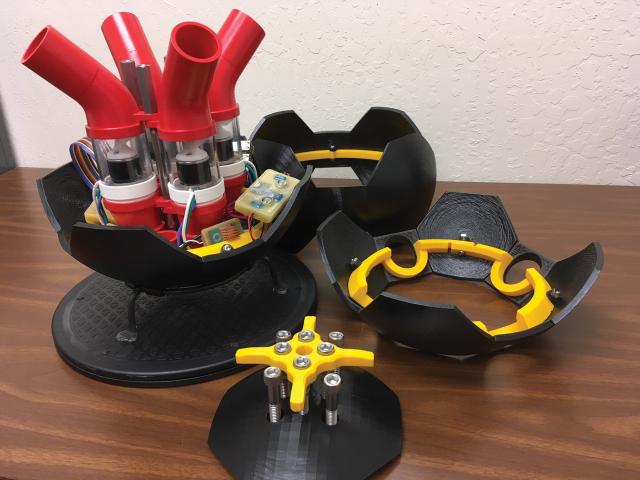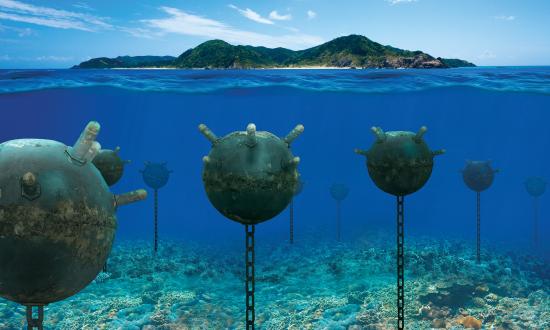The Navy’s offensive mine-warfare capability gap widens every year, as doctrinal foundations erode. Without significant and purposeful research, development, testing, and evaluation efforts, the Navy is likely to find itself entirely on the defensive end of mine warfare for the next several decades. To inform such research efforts, a cohort within the Systems Engineering Department at the Naval Postgraduate School looked to history for guidance. The first known use of mobile mines—in a minor naval footnote to the American Revolutionary War known as “The Battle of the Kegs”—led the team to pose the question: What would a 21st-century equivalent to that battle look like?
The Battle of the Kegs
In 1775, David Bushnell designed and built America’s first combat submarine, the Turtle. As important, if less often recognized, is that he also proved that gunpowder can ignite underwater. This niche expertise, with support from clockmaker Isaac Doolittle, produced the first mechanically triggered time bomb. In September 1776, the Continental Army employed the Turtle and a clock-fuzed bomb as an integrated combat system in an attempt to sink a British ship-of-the-line in New York Harbor.
The attempt failed. However, in realizing that the Turtle was impractical, Bushnell redirected his efforts to other offensive designs, and in less than a year, he again attempted to sink a British man-of-war. Concealed by the darkness of night, a small whaling boat towed two gunpowder-filled floating kegs into Niantic Bay. Using the current, he released the kegs in the direction of the British 28-gun frigate Cerberus. The frigate’s nearby tender, a schooner, snared one keg. Sailors on that boat attempted to hoist the keg aboard, igniting the contact fuse. The resulting detonation killed four British seamen and sank the schooner. Even though the Cerberus emerged unscathed, the attack caused the ship to sortie back to Newport, Rhode Island, to inform Royal Navy superiors of the new threat.
During a third attempt in Philadelphia Harbor in 1778, Bushnell increased the number of mines employed to 20 to improve the probability of success. Again relying on the prevailing current, the mines missed their mark, as the ships had anchored specifically to avoid hull-damaging ice floes in the Delaware River. Though the British fleet suffered no losses in the attack, Royal Navy commanders were so frightened by the explosion of one of the mines against a fishing boat that their forces spent the remainder of the night and the majority of the next day shooting at anything afloat. Author and composer Francis Hopkinson wrote a propaganda ballad recounting the attack as “The Battle of the Kegs.”
Though mines inflicted very little physical damage in the Revolutionary War, they created enough uncertainty to force a ship-of-the-line to get under way from anchorage in the middle of the night—a significant effect on an adversary for a few kegs of gunpowder. Furthermore, provoking frigate captains to command their crews to fire rounds into the Delaware River to protect their ships, when their logistic stronghold was on the other side of the Atlantic Ocean, is evidence of the disorder that using mines offensively can cause.
Offensive mine warfare works because, as the British fleet experienced, a mere indication the threat exists will influence an adversary’s decision-making. This remains true today, as very few sensors can reliably detect mines underwater. Even when mines are located, sophisticated and expensive systems are needed to defang them. With the rapid development of advanced technology in the 21st century, the time has come to reimagine offensive mining in support of controlling today’s maritime environment.
Gauging the Capability Gap
Today, Navy fighter and maritime patrol aircraft, along with Air Force strategic bombers, can carry and deliver Quickstrike mines. However, regardless of whether balloon parachutes or folding-fin-retarder tailkits are used, Quickstrike mines require specific deployment envelopes, typically below 500 feet in altitude and 300 knots in airspeed. These restrictions do not pose a significant survivability risk when the mines are deployed defensively, to protect U.S. or allied territorial seas and associated national airspace, which are generally uncontested. But in offensive mining, there is a high probability that friendly aircraft would face adversarial antiaircraft systems, perhaps as far out as the edge of the exclusive economic zone or even international airspace in substantial conflict.
At present, Navy surface ships can deploy neither offensive nor defensive mine systems. Submarine fleets are capable of launching mines, but both the Mk 60 CapTor encapsulated torpedo and the Mk 67 Submarine Launched Mobile Mine were withdrawn from service, in 2001 and 2012, respectively. The former lent itself well to sea control, while the latter was used for sea denial.
Furthermore, the mines that remain in the Navy’s inventory have the same tactical value as their predecessors—“weapons that wait.” But is this truly an advantage? Once minefields are laid, whether offensive or defensive, they remain in place until detonated or physically removed. As conflicts evolve, sea-control and sea-denial efforts follow, but the mines remain static, and they also are independent, lacking the ability to network with either each other or operational forces. Disarming them is possible only with the intervention of highly trained operators.
Current U.S. mines cannot distinguish friend from foe. In a sea-denial scenario, therefore, minefields may dissuade the enemy from leaving port, but they also prevent the Navy from gaining access to the area denied to the enemy. In sea-control scenarios, minefields make entire operational areas high risk. Only robust information sharing about mine placement mitigates this risk.
The Navy’s expertise dedicated to mine warfare, responsible for doctrine and operations, has deteriorated to a point of near nonexistence. The Navy currently employs only two minefield planners—a retired Coast Guard captain and a surface ordnance limited duty officer. To compensate, the Naval Surface and Mine Warfighting Development Center has invested considerable time and effort in training antisubmarine and antisurface warfare tactics instructors (WTIs) on mine warfare. But the enlisted crews required to conduct offensive mine warfare operations do not exist. Mineman (MN) rated billets are detailed exclusively to Avenger-class mine countermeasures ships, where they perform no offensive mining duties at all.
In short, the Navy lacks modern mines, platforms to deliver them, and sailors tactically knowledgeable enough to employ them offensively.
The Forward Edge of Offensive Mining
To address all three deficiencies, mine systems will require more than routine hardware and software updates; they will require a complete redesign. For the sake of expediency—a critical parameter—system designers should start from existing unmanned or autonomous underwater vehicles (UUVs/AUVs) as integration platforms. Researchers at the Naval Postgraduate School (NPS) have developed the Wreck Interior Exploration Vehicle (WIEVLE), a system designed to explore confined, submerged spaces such as shipwrecks. But it is capable of carrying a variety of payloads. The interior volume could easily manage sensor, communication, and even explosive payloads, all while allowing the vehicle to maneuver both quietly and efficiently.
WIEVLE has small magnetic and acoustic signatures compared with other AUVs. Though mine casings are traditionally machined from steel, advances in manufacturing now allow for spherical shells to be injection-molded or 3D printed with high-grade carbon fiber or plastics. A mine made from such materials would be extremely difficult to detect, except perhaps visually. Legacy mine systems create a large acoustic signature during launch and delivery, but WIEVLE uses a quiet integrated tunnel-thruster propulsion system, reducing both its acoustic profile and the probability of detection. A thruster system embedded within a tunnel is also unlikely to foul on undersea vegetation, a significant advantage in the littorals.
Though signature reductions and propulsion efficiencies are vital, they are insufficient. The greatest innovation will come from using next-generation software to combine individual mines into a swarming minefield. High-level functions to support swarming—including an electoral hierarchy of lead/follow relationships, artificial intelligence and machine-learning (AI/ML) processes, and optical communication mesh network topologies—already exist in commercially available software. As part of a swarm network, the individual mines and systems could continuously self-assess and monitor adjacent systems to elect ranks within a tiered hierarchy construct that abide by lead/follow relationships. NPS’s Advanced Robotic Systems Engineering Laboratory aerial drone systems already use such hierarchies.
In addition, integrating AI/ML and sensor technologies such as passive sonar alongside legacy target-detection devices would allow for highly accurate classification and identification of contacts. That would permit AI/ML algorithms to initiate a temporary disarming and standoff protocol within the mine system to manage safe passage for friendly vessels. Conversely, the same tools would be able to initiate a swarm response across the network against hostile contacts. This “invisible fence” protocol would support sea-denial and sea-control mission areas without hindering the Navy’s ability to move in and through them.
Given expectations that communication and navigation systems will be degraded or denied in any coming fight, the mine system should rely on high-fidelity blue-green laser optical communications. In February 2020, General Atomics Aeronautical Systems successfully tested its Airborne Laser Communication System with satellites in geosynchronous earth orbit, with data rates 300 times greater than conventional radio-frequency satellite communications. Blue-green lasers can pass through hundreds of feet of seawater, eliminating the need for the mine system to surface to communicate. This also would allow mines to be deployed in a meshed network topology. Metcalfe’s Law of networked systems suggests the effectiveness of such a minefield might scale to the square of the number of systems connected. Thus, ten networked mines would be ten times more effective than ten independent mines, and so forth. This is critical because the projection of power is directly proportional to the level of fear instilled in adversarial forces, as the Battle of the Kegs showed.
Weapons that Won’t Wait
If the Navy is deploying an offensive minefield, the operating environment will certainly be highly contested, making survival of the mine-launching platform a challenge. Low-radar-cross-section surface platforms, such as littoral combat ships, Zumwalt–class destroyers, and unmanned vehicles, could be used to deliver mine swarms at the edge of territorial waters. The envisioned mine system also could be deployed from Mk 68 submarine torpedo tubes or dry-dock shelters during clandestine operations, or even from aircraft. At 12 nautical miles offshore, the mine swarm could submerge and travel to the coast, coordinated and controlled by Defense Department optical communication satellites in geosynchronous orbit.
The Navy will not be able to maintain maritime dominance with weapons that wait—patiently hoping a hostile ship happens across a minefield will be insufficient. Technological advances provide the opportunity to revolutionize mine weapon systems and doctrine, allowing planners to send the mines to seek out hostile forces. Cooperative, mobile mines that leverage modern innovations—much like Bushnell’s “kegs”—will inform a dynamic sea-control and -denial strategy aimed at instilling fear and uncertainty in adversaries, whether they are moored in their homeports or conducting open-ocean operations. To be sure, technical challenges await and require addressing, but the time to reimagine and realize the potential of offensive mining has arrived.
1. Jose E. Balderrama, Alan Crocker, Mia Moore, Stephen T. Pease, and Vincent J. Ragona, Developing the Mine of the Future—The MADMAN (Maritime Area Denial Mine with Autonomous Navigation), master’s thesis (Monterey, CA; Naval Postgraduate School, 2018).
2. General Atomics, “GA-ASI Successfully Tests Air-to-Space Laser Communication System,” www.ga.com/ga-asi-successfully-tests-air-to-space-laser-communication-system.
3. General Atomics, “General Atomics Signs Memorandum of Understanding with Tesat Spacecom,” www.ga.com/general-atomics-signs-memorandum-of-understanding-with-tesat-spacecom.
4. Kimberly Underwood, “Laser Communications Offer Promise,” SIGNAL Magazine, 31 October 2018, www.afcea.org/content/laser-communications-offer-promise.
5. “MK 67 Submarine-Laid Mobile Mine (SLMM),” Federation of American Scientists, fas.org/man/dod-101/sys/ship/weaps/mk-67.htm.
6. “New CRADA between NPS, General Atomics Focused on Advanced Space Technologies—Stories—Naval Postgraduate School,” my.nps.edu/-/new-crada-between-nps-general-atomics-focused-on-advanced-space-technologies.
7. Ryan Pickrell, “A Mysterious Naval Mine Inexplicably Appeared off Washington State—This Is the Moment It Blew Up,” Business Insider, 29 August 2018.
8. ADM James Winnefeld Jr., USN (Ret.), and CAPT Syed Ahmad, USN (Ret.), “The Other Mine Warfare Will Work,” U.S. Naval Institute Proceedings 144, no. 7 (July 2018): 28–32.
9. Scott C. Truver, “Taking Mines Seriously: Mine Warfare in China’s Near Seas,” Naval War College Review 65, no. 2 (2012): 30–66.







